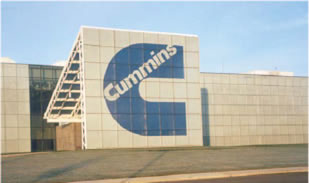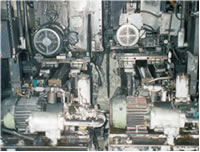Cummins Inc. Saves $200K Annually Using Energy-Efficient Motors
Mention Cummins engines to anyone who’s ever put the pedal to the metal in an 18-wheeler and you’ll probably hear words like value and efficiency. So it shouldn’t come as a surprise that Cummins Inc. also practices energy efficiency in its plants. Cummins management believes a proactive energy efficiency policy helps the company stay competitive.
 Cummins Inc., Columbus, Indiana.
Cummins Inc., Columbus, Indiana.In fact, Cummins’ energy savings have been so remarkable, the U.S. Department of Energy’s (DOE) Office of Industrial Technologies (OIT) granted the company its Industry Captains Command Award in 1999. This article describes how Cummins reduced energy consumption, created real benefits to the environment, and saved more than $200,000 per year in energy costs. And those savings wouldn’t have been possible without copper.
Working with Your Utility
Cummins’ award-winning energy program began in 1987. Public Service of Indiana (PSI) did a survey to determine where Cummins could reduce its energy consumption. Besides a number of beneficial changes, PSI recommended DOE’s Motor Challenge program. Since electric-motor-driven equipment consumes about 60% of all electricity produced in the USA, increasing motor efficiency by even a few percent adds up to big savings.
How big? DOE’s Paul Scheihing notes, “If every plant in the United States integrated motor system upgrades to the extent that Cummins did, American industry would save $1 billion annually in energy costs. This would be the equivalent of the amount of electricity supplied to the State of New York for three months.”
Working with Motor Challenge
 Block and head machining and transfer line at Cummins’ Columbus engine plant showing four of the line’s new energy-efficient motors. Cummins replaced 296 motors ranging from 1-125 hp with energy-efficient U-frame motors manufactured by U.S. Electrical Motors, a division of Emerson Electric Co. The energy-efficient motors’ windings contain more copper than standard motors, making them a few percent more efficient than the standard motors they replaced. The improved efficiency reduced Cummins’ power costs for this machining and transfer line, alone, by $80,000 per year.
Block and head machining and transfer line at Cummins’ Columbus engine plant showing four of the line’s new energy-efficient motors. Cummins replaced 296 motors ranging from 1-125 hp with energy-efficient U-frame motors manufactured by U.S. Electrical Motors, a division of Emerson Electric Co. The energy-efficient motors’ windings contain more copper than standard motors, making them a few percent more efficient than the standard motors they replaced. The improved efficiency reduced Cummins’ power costs for this machining and transfer line, alone, by $80,000 per year.Cummins became actively involved with Motor Challenge in 1995 at its main plant in Columbus, Indiana, and focused on the 296 motors that drive the plant’s engine block machining and transfer lines. While the line’s electric motors were reliable enough, their efficiency ratings were typical of those available 30 years ago.
“We studied the Motor Challenge information thoroughly. In the end, we got to the point where we realized we’d be better off throwing these things out,” recalls Tim Burke, Cummins director of administration and finance. That meant getting rid of more than 1,000 motors, including all spares as well as those in service.
Working with Your Consultant
Cummins brought in McBroom Electric Company of Indianapolis to take a close look at every motor on the production lines. Their audit projected that Cummins would save $80,000 per year in power costs by replacing all of the lines’ 1- to 125-hp standard-efficiency motors with energy-efficient motors. Cummins met that projection and also achieved an additional $128,000 in annual savings by replacing the motors in its new machining and assembly lines.
Life-Cycle Costing
Cummins Inc. has an inhouse standard for life-cycle costing of equipment. “In the case of energy-efficient motors,” Burke says, “annual energy savings provided the major incentive. But since installing the motors, … we now have all new motors in our upgraded transfer lines, so maintenance costs have been reduced, … and we can now point to the reduction in fossil fuel use and lower greenhouse gas emissions brought about by our energy-efficient motors as evidence of our corporate environmental awareness.”
MotorMaster+ software (from the U.S. Department of Energy), information on NEMA Premium motor guidelines (from the National Electrical Manufacturers Association) and other sources can help manufacturers and building owners get maximum returns on their motor investment.
Cummins Inc.: 800-343-7357
Emerson Electric: 314-553-2000
National Electrical Manufacturers Association: 978-858-0972
Also in this Issue:
- Kitchen Copper for More than Cooking
- Copper Forever: The Timeless Home
- Our Last Maker of Copper Cookware
- More Copper For Kitchens
- America's Oldest Coppersmith?
- Cummins Inc. Saves $200K Annually Using Energy-Efficient Motors
- Durable Bronze Replaces Vulnerable Zinc
- Winning Design Mainly Recycled Copper
- All-copper Accelerator
